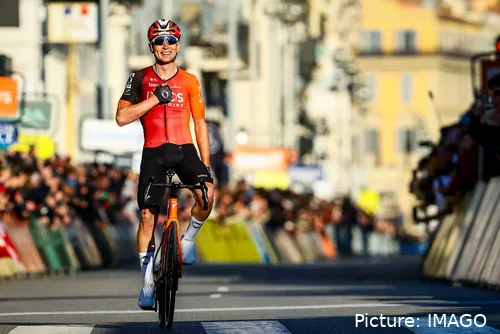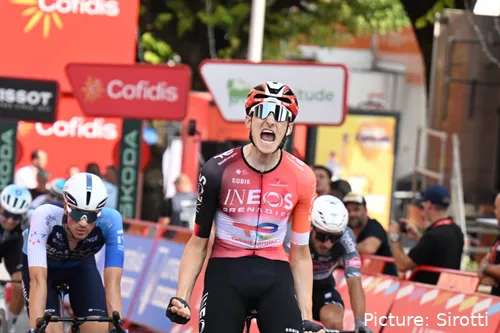Artem Shmidt surprised to take the title in the United States of American and fellow youngster Michael Leonard also surprised to win the battle up north in the Canadian nationals in June. Unfortunately for the team, it seems almost certain that neither will be in the team in 2026. In Europe, Filippo Ganna confirmed his credentials as the leading figure of the discipline in Italian cycling, whilst Bob Jungels and Tobias Foss won the Luxembourger and Norwegian titles respectively.
4. Magnus Sheffield at Paris-Nice
The American has evolved over the past few years into a rider who can do virtually anything in the peloton. When he is not in top form, he has often worked for other leaders. When he is, he can serve as a top time trialist, classics rider, breakaway specialist or even climber. At Paris-Nice, we saw the best of Magnus Sheffield’s climbing performances, perhaps the best of his career.
The sixth win of the year had as context a brutal week of racing in southern France, and a chaotic stage – as always – in the hills surrounding Nice. With a dangerous breakaway up the road, a few teams looked to control the race behind to try and raid race leader Matteo Jorgenson. INEOS had Thymen Arensman and at the time, the team led the GC group up the Côte de Peille controlling the group so as to not lose it. But after the summit the tactics changed, and Sheffield went on the attack. Mads Pedersen, Alexander Vlasov and Felix Gall (the latter two who previously attacked from the GC group) were in the head of the race and Sheffield caught up with them with a move on flat roads.Sheffield then powered up the final two climbs, dropping his rivals in the process and holding off the rampant Matteo Jorgenson who was flying behind, himself dropping Florian Lipowitz who later in the year would go on to finish third at the Tour de France.
Sheffield won the final stage of Paris-Nice. @Imago
3. Egan Bernal back to victories
Egan Bernal is a beloved rider and after his crash at the start of the 2022 season, his story captured the hearts of even more. Hence, for years fans have been eagerly anticipating his first pro win since the 2021 Giro d’Italia – a race he won overall. This happened at the Colombian national championships, on two occasions actually. But there is a difference between nationals and the big World Tour races to which he still has ambitions for.
This finally happened at the Vuelta a España. A day where no-one would’ve predicted that he actually sprinted to victory at the bottom of the final climb with approximately 8 kilometers to go, on a back road in the middle of Galicia. Bernal dropped out of GC contention during the Vuelta, but managed to show his best legs and on stage 16 he joined the day’s breakaway which would go on to battle for victory in the end.
Protests against Israel – Premier Tech would ultimately neutralize the finish entirely, but race organizers were ready for the scenario and innovated a new finish line at the bottom of the final ascent. Hence Bernal and Mikel Landa had one of the most unusual sprints imaginable for the stage win, but the Colombian did take it and it was his first official victory in the World Tour in over four years.
2. Ben Turner, the sprinter
Ben Turner’s evolution as a rider has been a very interesting one, with the 26-year old being signed in 2022 from Trinity Racing, following the steps of Tom Pidcock both when it comes to discipline but also successful past in cyclocross. Like Pidcock, Turner developed as a classics rider. But somewhere along the way things changed, for the positive however.
Turner’s classics credentials were never affected, but as the year’s went by, he has been put on several different roles with the team. At the 2024 Tour de France he was one of the team’s road captains and engines for the flat stages and hilly days. With the team lacking a true sprinter, and 2025’s attempt to have Caleb Ewan (who retired in the spring) being short lived, effectively the team did not have a fast man. Filippo Ganna experimented, but his top qualities lie elsewhere. Then the team experimented with Turner, and the Briton seems to have carved what is the ideal path for him.
At the Vuelta a Andalucia, he came close to beating Alexander Kristoff on a slight uphill spring, something which later in the year he would’ve perhaps won comfortably. At the Giro d’Italia he also hinted at this change, finishing third in a flat bunch sprint. Being 1.94 meters tall, even for a lean rider, the weight will still be high. In Turner’s case, 74Kg, according to ProCyclingStats. So the experiment continued.
And at the Tour de Pologne, it evolved into a winning formula. Turner won stage 3 into Walbrzych, winning comfortably an uphill sprint against puncheurs and GC riders. Out of those who can climb, he sprints best. The next two days he finished second only to Paul Magnier and Matthew Brennan, who need no presentation.
And at the Vuelta a España, Turner went on to win his first Grand Tour race, winning the sprint to Voiron on stage 4 ahead of none other than Jasper Philipsen. It was a tricky sprint, but there is no denying him a clean victory, in what was also a slight uphill sprint. He has a specialty, and in the hilly days he has turned into a menace for his rivals. The Vuelta victory came as a confirmation of the team’s successful project to turn him into a fast men this year.

Turner was victorious at this year’s fourth stage of La Vuelta. @Sirotti
1. Thymen Arensman beats Pogacar and Vingegaard at the Tour de France
Thymen Arensman takes the cake when it comes to this year’s big INEOS celebrations, and he did so at the Tour de France. His GC ambitions faded quickly in the first week, but as the Dutchman as shown multiple times in the past, his form tends to grow throughout Grand Tours. By the time the second week came by, the climber managed to save the team’s race by winning, from the breakaway, stage 14 of the race into Superbagnères. At the time, it was possible that Tadej Pogacar and UAE’s conservative tactics behind perhaps helped Arensman take the victory, whilst this did not happen in other days. The two are friends, as is known.
But on stage 19 to La Plagne, even if the same could be said, the victory of Thymen Arensman in the race’s final summit finish was fully to his merit. Again, Pogacar and Jonas Vingegaard raced very tactically up the Alpine mountain, but nevertheless it was a sight to behold to see Arensman flying off the front in the climb, and getting to the top faster than any other rider in the field. Even if you counted out the tactical racing between the two main favourites behind, Arensman climbed faster than third place Florian Lipwotiz and put minutes into most of the riders on the Top10. It was the best climbing performance of his career.
A marking victory for the Dutchman, perhaps career-changing even though it wasn’t his first in the race. He now gets to hang a picture of him beating this generation’s two best climbers on the wall, without having joined a breakaway or benefited from any mishap.

Arensman climbed the final summit finish to La Plagne faster than Tadej Pogacar and Jonas Vingegaard. @Sirotti

